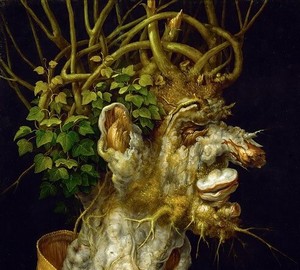
Description of the picture:
Winter – Giuseppe Arcimboldo. 1563. The panel, oil. 67 x 51 cm
This painting is part of a series of “Seasons”, written by the artist throughout his life. She is an allegory of winter – the least fertile period of the year.
The canvas depicts the image of winter in the form of a man, located in profile to the audience. If you carefully consider it, you will notice that the role of the body and head is played by the old clumsy tree, “turned upside down.” That is, the base of the tree depicts the head of an old man, his nose is a broken off rotting branch, his chin, with separate protruding “hairs” – this is a growth of wood with several growing shoots. The old man’s lips are two fungi, and the big ear is formed by a large rotten branch with a large hollow inside. His hair is the roots of a tree sticking up, intertwined with evergreen vegetation – ivy.
The clothes of “Winter” are a large golden mat in which his body is wrapped. The only decoration is the “winter” fruit. A pair of lemons on a common petiole are worn on a knot protruding from the “chest” of “Winter”.
Unlike other allegorical paintings by the master with lavish decor and the use of a large number of components, this one is distinguished by a modest number of graphic means, but it is this asceticism that best conveys the severity and poverty of the winter season."